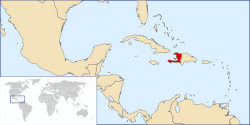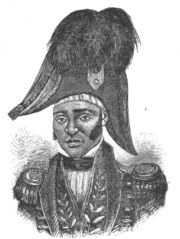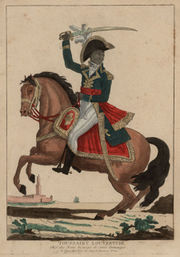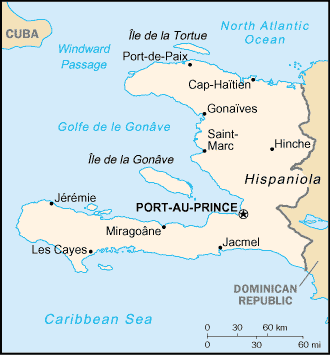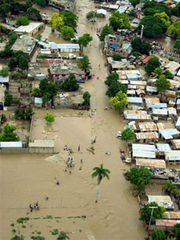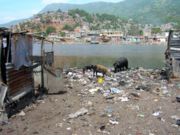Haiti
2008/9 Schools Wikipedia Selection. Related subjects: Americas; Countries
| République d'Haïti Repiblik d Ayiti Republic of Haiti
|
||||||
|---|---|---|---|---|---|---|
|
||||||
| Motto: "L'Union Fait La Force" (French) "Unity makes Strength" |
||||||
| Anthem: La Dessalinienne |
||||||
|
|
||||||
| Capital (and largest city) |
Port-au-Prince |
|||||
| Official languages | French, Haitian Creole | |||||
| Demonym | Haitian | |||||
| Government | Presidential republic | |||||
| - | President | René Préval | ||||
| - | Prime Minister | Jacques-Edouard Alexis | ||||
| Formation | ||||||
| - | as Saint-Domingue | 1697 | ||||
| - | Independence from France |
January 1, 1804 |
||||
| Area | ||||||
| - | Total | 27,750 km² ( 146th) 10,714 sq mi |
||||
| - | Water (%) | 0.7 | ||||
| Population | ||||||
| - | 2005 estimate | 8,827,000 ( 85th) | ||||
| - | 2003 census | 8,527,817 | ||||
| - | Density | 335/km² ( 38th) 758.1/sq mi |
||||
| GDP ( PPP) | 2007 estimate | |||||
| - | Total | $16.51 ( 124th) | ||||
| - | Per capita | $1913 ( 153rd) | ||||
| Gini (2001) | 59.2 (high) | |||||
| HDI (2007) | ▲ 0.529 (medium) ( 146th) | |||||
| Currency | Gourde ( HTG) |
|||||
| Time zone | ( UTC-5) | |||||
| - | Summer ( DST) | ( UTC-4) | ||||
| Internet TLD | .ht | |||||
| Calling code | +509 | |||||
Haiti (English pronounced /ˈheɪtiː/; French Haïti pronounced [aiti]; Haitian Creole: Ayiti), officially the Republic of Haiti (République d'Haïti ; Repiblik d Ayiti), is a French and Creole speaking Latin American country located in the Greater Antilles archipelago on the Caribbean island of Hispaniola, which it shares with the Dominican Republic. Ayiti (Land of Mountains) was the indigenous Taíno or Amerindian name for the island. The country's highest point is Pic la Selle, at 2,680 metres (8,793 ft). The total area of Haiti is 27,750 square kilometres (10,714 sq mi) and its capital is Port-au-Prince.
A formerly prosperous French colony, the island nation bears several historical feats: Haiti became the first independent black-led republic and the only nation ever to form from a successful slave rebellion. Haiti is also the second oldest non-native country in the Americas, after the United States, as well as the first (and therefore the oldest) nation in Latin America to declare its independence, on January 1, 1804.
Haiti has recently undergone a state of transition following the forced ousting of President Jean-Bertrand Aristide on February 29, 2004. The circumstances surrounding his departure from office are disputed. René Préval was elected president in his place on February 7, 2006, and took office in May of that year.
History
The island of Hispaniola, of which Haiti occupies the western third, was originally inhabited by the Taíno Arawak people. Christopher Columbus landed at Môle Saint-Nicolas on December 5, 1492, and claimed the island for Spain. Nineteen days later, the Santa Maria ran aground near the present site of Cap-Haitien; Columbus was forced to leave 39 men, founding the settlement of La Navidad. Ayiti, which means "mountainous land", is a name that was used by its early inhabitants, the Taíno-Arawak people.
The Taínos were a seafaring branch of the South American Arawaks. Taíno means "the good" or "noble" in their language. A system of cacicazgos ( chiefdoms) existed on Hispaniola; Marien, Maguana, Higuey, Magua and Xaragua.
One of the earliest leaders to fight off Spanish conquest was Queen Anacaona, a Taíno princess from Xaragua who married Chief Caonabo, a Taíno chief ( cacique) from Maguana. The two fought hard against the Europeans; she was captured by the Spanish and executed in front of her people. Other noted Taíno leaders from Haiti are Chief Guacanagari, Chief Guama and Chief Hatuey (who later fled to Cuba and helped fight the Spaniards there). Cacique Henri, another Taíno chief, fought victoriously against the Spaniards in the Bahoruco to gain freedom for himself and his people. The town associated with this history is Anse a Pitres, near the south-eastern town of Jacmel. The Taínos as the Europeans saw them on the island of Hispaniola are virtually extinct. The survivors that escaped death mixed with African slaves (runaways called maroons), producing a small generation of zambos. The mestizo increased in number as native women conceived to European men. The Taíno bloodline in Hispaniola diluted more and more as the decades went by primarily due to the establishment of Africans and mulattos on the island; however, it is believed that a small number of Haitians and Dominicans retain some native ancestry.
Colonial rule
Enslavement, harsh treatment of the natives, and especially epidemic diseases such as smallpox caused the Taíno population to plummet over the next quarter-century. In response, the Spanish began to import African slaves to search for gold on the island. Spanish interest in Hispaniola waned after the 1520s, when vast reserves of gold and silver were discovered in Mexico and South America.
Fearful of pirate attacks, the king of Spain in 1609 ordered all colonists on Hispaniola to move closer to the capital city, Santo Domingo. However, this resulted in British, Dutch and French pirates establishing bases on the island's abandoned northern and western coasts. French settlement of the island began in 1625, and in 1664 France formally claimed control of the western portion of the island. By the 1697 Treaty of Ryswick, Spain ceded the western third of Hispaniola to France. France named its new colony Saint-Domingue.
While the Spanish side of the island was largely neglected, the French side prospered and became the richest colony in the Western Hemisphere, exporting large amounts of sugar and coffee. French colonial society contained three population groups: Europeans (about 32,000 in 1790) who held political and economic control; the gens de couleur, some 28,000 free mulattos and blacks who faced second-class status; and the slaves, who numbered about 500,000. (Living outside French society were the maroons (escaped ex-slaves who formed their own settlements in the highlands along with a very small number of Arawak survivors.)
Revolution
Inspired by the French Revolution, the gens de couleur pressed the colonial government for expanded rights. In October 1790, 350 revolted against the government. On May 15, 1791, the French National Assembly granted political rights to all blacks and mulattoes who had been born free - but did not change the status quo regarding slavery. On August 22, 1791, slaves in the north rose against their masters near Cap-Français (now Cap-Haïtien). This revolution spread rapidly and came under the leadership of Toussaint L'Ouverture. He is commonly referred to as the "Black Napoleon." He soon formed alliances with the gens de couleur and the maroons, whose rights had been revoked by the French government in retaliation for the uprising.
Toussaint' armies defeated the French colonial army, but then joined forces with it in 1794, following a decree by the revolutionary French government that abolished slavery. Under Toussaint's command, the Saint-Domingue army then defeated invading Spanish and British forces. This cooperation between Toussaint and French forces ended in 1802, however, when Napoleon sent a new invasion force designed to subdue the colony; many islanders suspected the army would also reimpose slavery. Napoleon's forces initially were successful at fighting their way onto the island, and persuaded Toussaint to a truce. He was then betrayed and captured and died in a French prison. Toussaint's arrest and the news that the French had reestablished slavery in Guadeloupe, led to the resumption of the rebellion, under the leadership of Jean-Jacques Dessalines and Henri Christophe, two of Toussaint's generals. Napoleon's forces were outnumbered by the combination of Jean-Jacques Dessalines, Henri Christophe, and Alexandre Petion, the "Generals of the Revolution."
Independence
Dessalines's armies won their final and decisive victory over the French forces at the Battle of Vertières on 18 November 1803, near Cap-Haitien. On 1 January 1804 the nation declared its independence, securing its position as the second independent country in the Americas, and the only successful slave rebellion in world history. Dessalines was its first ruler. The name Haiti was chosen in recognition of the old Arawak name for the island, Ayiti.
The new State of Haiti supported the abolitionist cause wherever possible. Haiti aided Francisco de Miranda and Simón Bolívar, giving them refuge and supporting their revolutionary efforts under the condition he free South America's slaves. The slaveholding powers surrounding Haiti isolated the new nation under a cordon sanitaire, fearing slave revolutions of their own. The Haitian Revolution is thought to have inspired numerous slave revolts in the Caribbean, Brazil and United States. The blockade was virtually total. The Vatican withdrew its priests from Haiti, and did not return them until 1860. France refused to recognize Haiti's independence until it agreed to pay an indemnity of 150 million francs, to compensate for the losses of French planters in the revolutions, in 1833. Payment of this indemnity brought the government deeply in debt and crippled the country's economy.
In 1806, Dessalines, by now Emperor, was murdered in a power struggle with political rivals who thought him a tyrant. The nation divided into two parts, a southern republic founded by Alexandre Pétion (mulatto), becoming the first black-led republic in the world, and a northern kingdom under Henri Christophe. Christophe was responsible for the order and oversight of the construction of two New World marvels; his capital palace of Sans Souci and the massive Citadelle Laferrière, the largest fortress in the Western hemisphere.
In August 1820, King Henri I (Henri Christophe) suffered a stroke that left him partially paralyzed. When the news spread of his infirmities, the whispers of rebellion, deceit and treachery began. On October 2, 1820, the military garrison at St. Marc led a mutiny that sparked a revolt. The mutiny preempted a conspiracy of some of Christophe's most loyal generals. Some of his trusted aides took him from the palace of Sans-Souci up to his Citadel, to await the inevitable confrontation with the rebels. Christophe ordered his attendants to dress him in his formal military uniform and for two days desperately tried to raise the strength to lead out his troops. Finally, he ordered his doctor to leave the room. Shortly after he left, Christophe shot and killed himself.
Following Christophe's death, the nation was reunited as the Republic of Haiti under Jean-Pierre Boyer, Petion's successor. Boyer invaded the Spanish colony of Santo Domingo and proclaimed the entire island under Haitian rule, until 1844 when the Dominican Republic gained its independence separating the island into two countries. The Dominican Republic's independence constitutes the only independence campaign in the New World in one Latin American country from another. (Uruguay got it's independence from Brazil in 1828 and Uruguay used to be called the Cisplatine Province when it was part of Brazil).
US occupation
Throughout the nineteenth century, Haiti was ruled by a series of presidents, most of whom remained in office only briefly. Meanwhile, the country's economy was gradually dominated by foreigners, particularly from Germany. Concerned about German influence and growing military presence, and disturbed by the savage public dismembering of President Guillaume Sam by an enraged crowd, the United States invaded and occupied Haiti in 1915. The United States imposed a constitution written by future president Franklin D. Roosevelt, and applied an old system of compulsory corvée labor to everyone. Previously this system had been applied only to members of the poor, black majority.
Nationalist rebels, called Cacos, waged a persistent guerilla warfare, headed by Charlemagne Péralte (until 1919) and Dominique Batraville (until 1920). Roosevelt was disenchanted with the burden and negative social aspects of attempting to impose U.S. influence on the population and proceeded to implement an earlier disengagement agreement, thereby ending the U.S. occupation in 1934.
The Duvaliers
The United States left Haiti in the hands of the mulatto minority, but in 1946 Dumarsais Estimé became the country's first black president since the beginning of the U.S. occupation. His efforts at reform sparked disorder, and when he attempted to extend his term of office in 1950 (as most previous presidents had done) there was a coup, followed by the second formal Military Council of Government led by Paul Magloire.
François Duvalier, also known as "Papa Doc", was an ex-doctor who ruled as dictator of Haiti from 1964 until his death in 1971. In 1957, Dr. François Duvalier came to power in the country's first universal suffrage election; many believed this outcome was manipulated by the army. In 1964, he declared himself president for life. Duvalier maintained control over the population through his secret police organization, the Volunteers for National Security - nicknamed the Tonton Macoutes ("boogeymen") after a folkloric villain. This organization drew international criticism for its harsh treatment of political adversaries, both real and suspected. Upon Duvalier's death in 1971, he was succeeded by his nineteen year-old son Jean-Claude Duvalier (nicknamed "Baby Doc") as Haiti's new president for life. The younger Duvalier regime became notorious for corruption, and was deposed in 1986, ushering in a new period of upheaval.
Aristide
The priest Jean-Bertrand Aristide was elected president on December 16, 1990. He took office on February 7, 1991, becoming Haiti's first democratically elected leader, but was deposed in a U.S. supported coup on September 30, 1991, less than eight months after his inauguration. There followed three years of control by a military junta led by Raoul Cedras, before a second U.S. invasion and occupation in 1994 returned Aristide to power on condition he accept a U.S. design economic program. One of the first acts of the re-installed government of Aristide was to disband the army.
Aristide was succeeded by a one-time ally and former prime minister, René Préval, in 1996. Préval's administration is notable for the fact that he was the first president in Haiti's history to constitutionally succeed a former president, serve a complete term, and leave his office voluntarily at the prescribed time. Every previous president had either died in office, been assassinated, been deposed, overstayed his prescribed term, or been installed by a foreign power.
Aristide returned to office in 2001 after elections that were boycotted by many of his opponents, who accused his party, Fanmi Lavalas, of counting votes improperly in a previous senatorial election, as well as threatening critics. Aristide denied the charges and accused his opponents of accepting U.S. assistance, and plotting to overthrow his government. The opposition mostly denied this, but many of its members continually called for his early resignation.
In February 2004, following months of large-scale protests against what critics charged was an increasingly corrupt and violent rule, violence spread through Haiti, involving conflicts between the government and various rebel groups. Under pressure from both foreign governments and internal sources, and with the rebel army approaching the capital, Aristide was forced to resign and fled the country, going into exile in the Central African Republic on February 29. Aristide later alleged that he faced pressure from the U.S. Armed Forces and American officials from the United States' embassy in Port-au-Prince. At the time, the United States and some of Aristide's own security agents claimed that Aristide had agreed to leave the country willingly and that it had escorted him to Africa for his own protection. As Aristide departed the country, many members of his government fled or went into hiding, and the United States again sent Marines into Port-au-Prince. After Aristide's departure, Supreme Court Chief Justice Boniface Alexandre succeeded to the presidency appointed by a council of elders and supported by the United States, Canada, and France.
In the months following the February Coup, the country was engulfed in violence between the interim government's forces and Lavalas supporters, and many members of the Lavalas party were sent to jail, exiled, or killed. Over 10,000 workers in Haitian civil enterprises lost their jobs following the coup.
Elections were held in February 2006, and René Préval was again elected president. Preval has promised to bring peace and stability to the country. (See Haitian elections, 2006.)
Politics
The politics of Haiti takes place in the framework of a presidential republic, and of a pluriform multi-party system, whereby the President of Haiti is the head of state, while the Prime Minister is head of government. Executive power is exercised by the government. Legislative power is vested in both the government and the two chambers of the National Assembly of Haïti.
Departments, arrondissements, and communes
Haiti is divided into 10 departments. The departments are listed below, with the departmental capital cities in parentheses.
- Artibonite ( Gonaïves)
- Centre ( Hinche)
- Grand'Anse ( Jérémie)
- Nippes ( Miragoâne)
- Nord ( Cap-Haïtien)
- Nord-Est ( Fort-Liberté)
- Nord-Ouest ( Port-de-Paix)
- Ouest (Port-au-Prince) *national capital*
- Sud-Est ( Jacmel)
- Sud ( Les Cayes)
The departments are further divided into 41 arrondissements, and 133 communes which serve as second and third level administrative divisions.
Geography
Haiti is situated on the western part of the second largest island in the Greater Antilles, Hispaniola. Haiti is the third largest country in the Caribbean only behind Cuba and the Dominican Republic respectively. Haiti at its closest point is only 80 kilometres (43 nmi) away from Cuba. Haiti's terrain consists mainly of rugged mountains with small coastal plains and river valleys. The country's largest crop-producing and one of Haiti's most fertile river valleys is the Plaine de l'Artibonite. The east and central part of the island is a large elevated plateau. The highest point in Haiti is Pic la Selle at 2,680 metres (8,793 feet). The 360 kilometre (224 mile) border is shared with the Dominican Republic. Haiti also contains several islands. The famous island of Tortuga (Île de la Tortue) is located off the coast of northern Haiti. The arrondissement of La Gonâve is located on the island of the same name, in the Gulf of Gonave. Gonave Island is moderately populated by rural villagers. Île à Vache (Island of The Cow) is located off the tip of southwestern Haiti. It is a rather lush island with many beautiful sights. Also part of Haiti are the Cayemites and Ile de Anacaona.
In 1925, Haiti was a lush tropical paradise, with 60% of its original forest covering the lands and mountainous regions. Since then, the population has cut down all but 2% of its forest cover, and in the process has destroyed fertile farmland soils, while contributing to desertification. Erosion has been severe in the mountainous areas.}. Most Haitian logging is done to produce charcoal, the country's chief source of fuel. The plight of Haiti's forests has attracted international attention, and has led to numerous reforestation efforts, but these have met with little success to date. Despite the large environmental crises, Haiti retains a very high amount of biodiversity in proportion to its small size. The country is home to more than 6,000 plants in which 35% are endemic and 220 species of birds in which 21 species are endemic. The country's high biodiversity is due to its mountainous topography and fluctuating elevations in which each elevation harbors different microclimates and its own endemic fauna and flora. The country's varied scenery include lush green cloud forests (in some of the mountain ranges and the protected areas), high mountain peaks, cactus-strewn desert landscapes (due to the deforestation), and palm tree-lined beaches.
Environmental issues
In addition to soil erosion, the deforestation has also caused periodic flooding, as seen on 17 September, 2004. Tropical storm Jeanne skimmed the north coast of Haiti, leaving 3,006 people dead in flooding and mudslides, mostly in the city of Gonaïves. Earlier that year in May, floods killed over 3,000 people on Haiti's southern border with the Dominican Republic.
Currently the country is seeking to implement a biofuel solution to its energy problems.
There has been a dispute between the United States and Haiti about Navassa Island (Navasse), which both countries claim. The Haitian claim relies on documentation that Navassa became part of Haiti after a 1697 agreement between France and Spain that gave France the western third of Hispaniola plus nearby islands, including Navassa Island. The United States claims the island pursuant to its own Guano Islands Act of 1856.
Economy
Haiti remains the least-developed country in the Americas, largely due to political instability and repeated episodes of violence. Comparative social and economic indicators show Haiti falling behind other low-income developing countries (particularly in the hemisphere) since the 1980s. Haiti now ranks 146th of 177 countries in the United Nations Human Development Index (2006). About 80% of the population were estimated to be living in poverty in 2003. Haiti is the only country in the Americas on the United Nations list of Least Developed Countries. Economic growth was negative in 2001 and 2002, and flat in 2003.
About 66% of all Haitians work in the agricultural sector, which consists mainly of small-scale subsistence farming, but this activity makes up only 30% of the GDP. The country has experienced little formal job creation over the past decade, although the informal economy is growing. It has consistently ranked among the most corrupt countries in the world on the Corruption Perceptions Index.
Foreign aid makes up approximately 30%-40% of the national government's budget. The largest donor is the United States, and European nations also contribute. Venezuela and Cuba also make various contributions to Haiti's economy, especially after alliances were renewed in 2006-7.
U.S. aid to the Haitian government was completely cut off in 2001-2004 after the 2000 election was disputed and President Aristide was accused of various misdeeds. After Aristide's departure in 2004, aid was restored, and the Brazilian army led the United Nations Stabilization Mission in Haiti peacekeeping operation.
Education
Of Haiti's 8.8 million inhabitants, just under half are illiterate. The literacy rate is the lowest in the region with 52.9%. Haiti counts with 15,200 primary schools, of which 90% are non-public and managed by the communities, religious organizations or NGOs. The enrollment rate for primary school is 67%, of which less than 30% reach 6th grade, and for secondary school is 20%.
The educational system of Haiti is based of the French system. Higher education is provided by universities and other public and private institutions and is under the responsibility of the Ministry of Education.
A list of universities in Haiti includes:
- Université Caraïbe (CUC)
- Université Chrétienne du Nord d'Haïti (UCNH)
- Université d'État d'Haïti (UEH)
- Université Lumière / MEBSH
- Université Notre Dame d'Haïti (UNDH)
- Université Quisqueya (UNIQ)
- Université Roi Henri Christophe
- Université Publique de l'Artibonite aux Gonaïves (UPAG)
- Université Publique du Nord au Cap-Haïtien (UPNCH)
- Université Publique du Sud au Cayes (UPSAC)
Demographics
Although Haiti averages approximately 250 people per square kilometer (650 per sq. mi.), its population is concentrated most heavily in urban areas, coastal plains, and valleys. About 95% of Haitians are of predominantly African descent. The influential remainder of the population vary in ethnic groups from mulattoes, mestizoes, to Arabs (primarily Lebanese) and Europeans. White-descended Haitians are mainly of French, Polish, Spanish, Italian, and German heritage. There is also a small Asian (mostly Chinese) presence within the minority.
Haitian diaspora
As with many other poor Caribbean nations, there is a large diaspora, which includes many, often illegal, immigrants in nearby countries. Millions of Haitians live abroad, chiefly in the Dominican Republic, Bahamas, Cuba, French Guiana, the Lesser Antilles, Canada, France, and the United States.
In the United States
There is a sizable community of Haitian émigrés residing in Miami's "Little Haiti" section. In New York City, the Brooklyn neighborhoods of Flatbush, Crown Heights, and Canarsie is also home to a thriving émigré community. In the neighboring Queens, communities can be found in the Jamaica, Queens Village, Hollis, Rosedale and Cambria Heights sections of that borough. Other cities where notable communities have formed include Boston, Cambridge, Malden and Brockton (all in Massachusetts), Philadelphia, Pennsylvania, Washington D.C., Bridgeport, Connecticut, Chicago, Illinois, Tampa and Orlando (both Florida), East Orange , Irvington and Newark (all three in New Jersey), and New Rochelle and Spring Valley (both New York State).
Languages
Haiti's official languages are French and Haitian Creole (Kreyòl Ayisyen). Nearly all Haitians speak the latter natively, a creole based primarily on French (90 percent of Haitian Creole vocabulary is French in origin), with significant African influence along with that of Spanish, Portuguese, and Taíno to a lesser extent. French is however the principal written and administrative language, used by many educated Haitians.
Spanish is spoken near the border with the Dominican Republic, and is increasingly being spoken in more westward areas, as Venezuelan, Cuban, and Dominican trade influence Haitian affairs, and Haiti becomes increasingly involved in Latin American transactions. English is also a very popular language, due to its position as an international language and Haiti's close ties with the United States.

